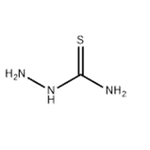Chemical Properties
white crystalline solid
Chemical Properties
Thiosemicarbazide is an odorless, white crystalline powder.
Uses
Used in TLC to stain alpha-keto acidsThiosemicarbazide is used as a reagent for ketones as well as chemical intermediate. It is involved in the detection of metals. It is also used in photography. Further, it is effective for controlling bacterial leaf blight in rice. In addition to this, it is used to prepare 1,3,4-thiadiazoles.
Uses
As a reagent for detection of metals.
Definition
ChEBI: Hydrazinecarbothioamide is a member of the class of thioureas that is thiourea in which a hydrogen of one of the amino groups is replaced by an amino group. It is a member of hydrazines, a thiocarboxamide and a member of thioureas.
General Description
N-Aminothiourea is a white crystalline powder and is odorless. N-Aminothiourea is used as a reagent for ketones and certain metals, for photography and as a rodenticide. N-Aminothiourea is also effective for control of bacterial leaf blight of rice. Not a registered pesticide in the U.S. N-Aminothiourea is a chemical intermediate for herbicides and a reagent for detection of metals.
Reactivity Profile
Isocyanates and thioisocyanates are incompatible with many classes of compounds, reacting exothermically to release toxic gases. Reactions with amines, aldehydes, alcohols, alkali metals, ketones, mercaptans, strong oxidizers, hydrides, phenols, and peroxides can cause vigorous releases of heat. Acids and bases initiate polymerization reactions in these materials. Some isocyanates react with water to form amines and liberate carbon dioxide. Base-catalysed reactions of isocyanates with alcohols should be carried out in inert solvents. Such reactions in the absence of solvents often occur with explosive violence, [Wischmeyer(1969)].
Health Hazard
N-Aminothiourea is highly toxic by ingestion. May induce goiter and cause delayed toxic effects in blood and skin. May be mutagenic in human cells.
Fire Hazard
When heated to decomposition, very toxic fumes of sulfur oxides and nitrogen oxides are emitted.
Flammability and Explosibility
Non flammable
Safety Profile
Poison by ingestion,
intraperitoneal, and intravenous routes.
Questionable carcinogen with experimental
tumorigenic data. Human mutation data
reported. When heated to decomposition it
emits very toxic fumes of NOx and SOx.
Potential Exposure
Thiosemicarbazide is a dithiocarbamide compound is used as an intermedialte for pharmaceuticals and herbicides; as a reagent for ketones and certain metals; in certain photography and dye operations; as a rodenticide. It is also effective for control of bacterial leaf blight of rice.
Shipping
UN2771 Thiosemicarbazide, pesticides, solid, toxic, Hazard Class: 6.1; Labels: 6.1-Poisonous materials. UN2811 Toxic solids, organic, n.o.s., Hazard Class: 6.1; Labels: 6.1-Poisonous materials, Technical Name Required.
Purification Methods
Crystallise thiosemicarbazide from H2O (solubility is 20.3% w/w at 80o). The hydrochloride has m 190-191o(dec, 184o also reported). It forms salts with heavy metals. [Beilstein 3 H 195, 3 I 79, 3 II 134, 3 III 315, 3 IV 374.]
Incompatibilities
Incompatible with oxidizers (chlorates, nitrates, peroxides, permanganates, perchlorates, chlorine, bromine, fluorine, etc.) and strong reducing agents; contact may cause fires or explosions. Keep away from alkaline materials, strong bases, strong acids, oxoacids, epoxides. May react with nitrates.




